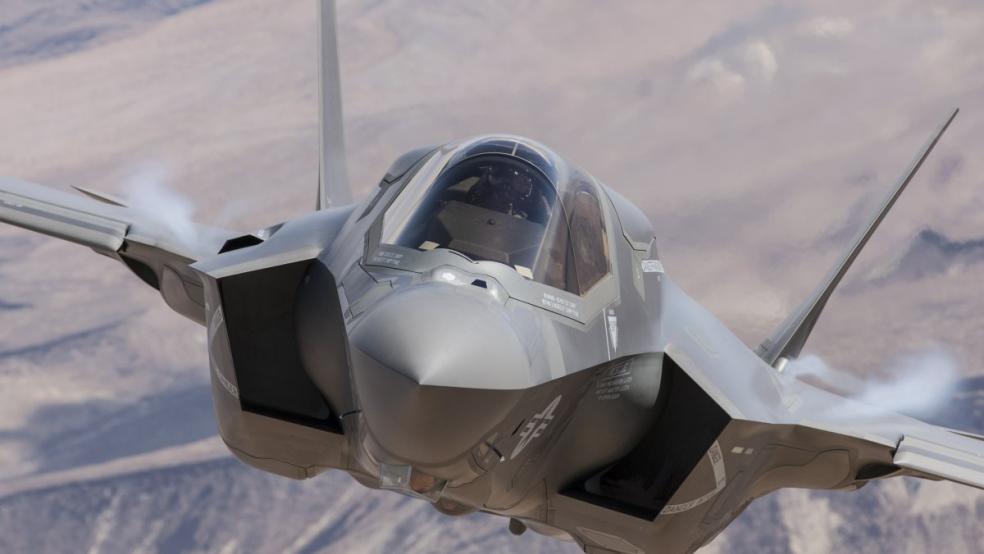The Defense Department’s multi-billion dollar F-35 Joint Strike Fighter effort has hit a new snag, and it’s one that could take anywhere from a year to 18 months to fix, according to the program’s chief.
Earlier this month Defense News reported the Pentagon had learned the fifth-generation airplane’s ejection seat could cause fatal whiplash for pilots weighing under 136, despite the fact that the seat was designed to handle any pilot weighing between 103 and 245 pounds.
Related: How the Liberal’s Win in Canada Could Hurt the F-35
The discovery prompted the Pentagon to restrict any pilot that weighs less than 136 pounds from flying the aircraft until a solution was found.
Air Force Lt. Gen. Christopher Bogdan, the head of the F-35 program office, told House lawmakers on Wednesday that officials are using “known fixes” to remedy the problem, though they’ll take some time to implement.
With a price tag of around $400 billion, the F-35 is the costliest weapon in U.S. history; the idea that the severely delayed procurement effort suffered another technical glitch on a support system many believed was safe set off alarm bells on Capitol Hill, even among the fighter’s supporters.
"Obviously [the seat] is not performing … This is supposed to be life-saving, not life-threatening," House Armed Services Tactical Air and Land Forces subcommittee chair Mike Turner (R-Ohio) said Wednesday.
Related: The $1 Trillion Question for the F-35: Is the U.S. Buying an Inferior Plane?
Bogdan, rattling off a laundry list of ways program officials intend to fix the problem, including making the plane’s helmet lighter, seemed relatively unconcerned about the latest hiccup.
That’s not a cheap proposition. The helmet, built specifically for the F-35, costs around $400,000. Right now it weighs 5.1 pounds; technicians estimate they need to bring that down to 4.8 pounds, according to Bogdan.
He said they planned to leave the helm’s complex suite of technology alone and instead focus on replacing its straps and cushioning with “something lighter and stronger,” as well as removing its double-visor for day and night conditions. Pilots would have to physically switch them out instead.
Another fix is to install a switch on the side of the ejection seat that allows a pilots to set it for “light” or “heavy” weight, Bogdan told lawmakers. He didn’t give an estimate for how much the new fixes would cost to install.
Related: The Flawed F-35: Why the Pentagon Will Never Shoot It Down
As it stands, he said, pilots weighing less than 136 pounds have a 1 in 50,000 chance of neck injury; those between 136-165 pounds have a 1 in 200,000 chance.
It’s been a tough couple of days for the F-35. On Monday, Canada overwhelming elected the Liberal Party and its leader, Justin Trudeau, as prime minister. Trudeau made a promise on the campaign trail to nix Ottawa’s planned order of 65 JSFs, saving the country $9 billion.
For his part, Bogdan said it would be “inappropriate” to comment on Trudeau’s pending decision since he’s “received no official notification from Canada” that it’s backing out of the program.
He said that if Canada, or any of the nine partner countries developing the F-35, skipped out of the effort about $1 million would be added to the cost of each fighter jet. Considering the U.S. wants to purchase 2,440 F-35s over the coming years, that could add billions more to the program’s long-term $1 trillion cost and force the Pentagon to radically reduce its total buy.
Along with the U.S. and Canada, the United Kingdom, Italy, Netherlands, Turkey, Australia, Denmark and Norway are all helping to develop the JSF.
Bogdan said Canada’s 2.1 percent for future modernization and sustainment costs for the F-35 fleet would also have to be spread among the partners and that the remaining countries would need to “have a discussion about what to do with” Canada’s industrial base that has already won around $600 million to develop the jet.





